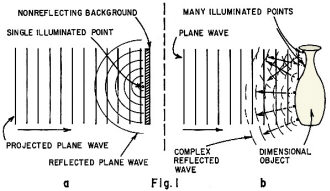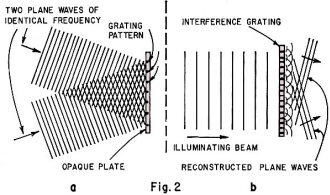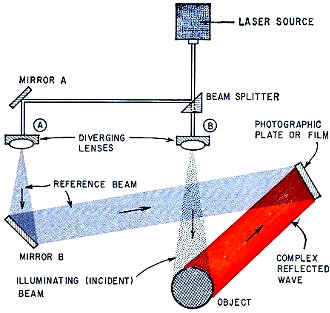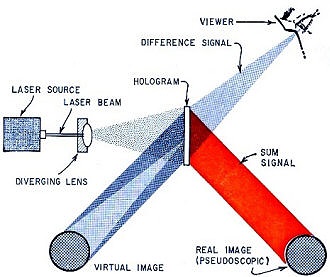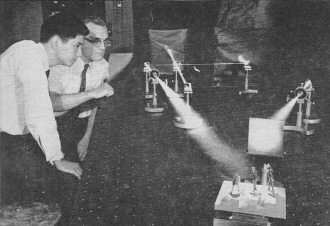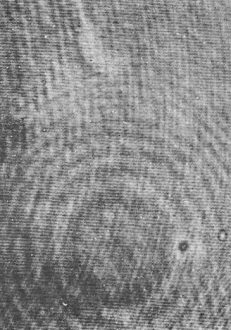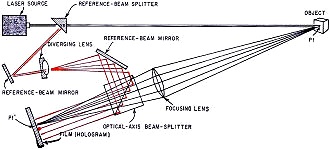Direct-View 3-D Images!
|
|
sink-me
A startling new scientific technique can create images so real you al-most think you can touch them Fig. 1 - Coherent light reflected (a) from a single point and (b) from many points. Note circular reflected wave patterns. By Allen B. Smith Three-dimensional images, which could be viewed without glasses, goggles or filters, have long been dreamed of. Most of us are so accustomed to viewing photographs - which are really abstract representations of real objects - that we find it difficult to imagine solid-appearing images. Such images are no longer dreams. They are being created right now. During a recent trade-show demonstration of a new optical technique for creating images of remarkable reality, a respected physicist viewed an image intently, then reached out his hand. Encountering nothing but air, he shook his head slowly. "I've been reading about this for months," he said. "But I honestly didn't expect to see such a perfect image. It's really a little spooky!" Known variously as laser photography, lasography, lens less photography and wavefront-reconstruction photography, laser holography resembles photography in only one respect - each records a pattern of light waves on a light-sensitive plate or film. Human vision depends on the fact that white light falling on an object is reflected in several ways, each of which carries some specific information about the object. Three types of information are particularly significant: intensity (amplitude), direction (phase) and color (frequency). If it were possible to record all these elements, the object could then be reconstructed in image form. The recreated image would be identical to the original object; it would, in fact, be impossible to distinguish the two except by touch. The problem is complex, however, because white light contains all wavelengths of visible light, from 3,800 Angstroms (violet) to 7,500 (deep red). Since each microscopic point on the surface of any object reflects the amplitude and phase, as well as the color, of each discrete wavelength, white light reflected from even the simplest object contains a staggering amount of information. No means has yet been discovered to record it all. Fig. 2 - Two laser beams interact (a) on plate, form grating illuminating beam (b) recreates original waves from grating. A logical approach to the problem would be to develop some means of recording the amplitude and phase information using spectrally pure light - that is, light of a single wavelength. Early attempts by Gabor to use filters and minute point-source apertures to obtain useful narrow bands of monochromatic light were handicapped. Such techniques produced illumination levels too low to be useful. Gabor did, however, develop a technique for recording amplitude and phase information on what he called holograms. These holograms (from the Greek holos, meaning whole) were light-wave records, captured as patterns on photographic plates, which contained phase and amplitude information from reflected light waves. Image quality of early holograms was very poor, however, as a result of the impure light used to form them. Nearly 15 years elapsed between Gabor's early experiments and the development of a light source having the unique properties necessary for making high-resolution holographic images. With the development of the laser, experimenters in several laboratories - particularly at the University of Michigan - began using the laser beam for making holograms. Made to order for this kind of optical recording, the laser emits light of a specific frequency from an extremely small point source. These qualities of temporal (frequency) and spatial (from a single source) purity are known as coherency, the unique quality of laser light. The processes of recording reflected light waves (making a hologram) and reconstructing the recorded waves (making a visual image) depend on two basic optical phenomena. The first is known as interferometry, an optical method for converting phase relationships into equivalent visual amplitude variations that can be recorded as a photographic pattern. The second, wavefront reconstruction, is a technique for transforming the pattern of recorded light waves on the hologram into an equivalent visible light beam. This light beam exhibits precisely the same characteristics of amplitude and phase as the light used in making the hologram. In other words, the reconstructed image looks exactly like the original object. If coherent light from a laser is beamed onto a single reflective point, the reflected wave will radiate from the point in a series of ever-expanding, concentric, hemispherical energy pulses called wavefronts (Fig. 1-a). These wavefronts travel outward from the point until absorbed or diffused. Suppose that, instead of a single point, the laser beam illuminated an object consisting of a large number of reflecting points. (Any two- or three-dimensional object contains such points.) In this case, the result is a complex wave pattern made up of all wavefronts reflected from and concentric to each separate point. This badly scrambled wave (Fig. 1-b ) contains all the data required to form an image of the object. Fig. 3 - The holographic arrangement for recording images. Fig. 4 - To view recorded hologram, this setup is used. Bell Labs scientists examine mixed-beam holographic apparatus making color recording. Hologram grating pattern and whorls. Since the complex wave cannot be recorded directly without destroying certain essential information, it must be modified by using interferometric techniques. The phase variations are thereby converted into amplitude equivalents. When this is accomplished, a photosensitive plate can be used to form a permanent record of the complex wave. Fig. 2-a illustrates a simple case of light-wave interference in which two identical plane waves (wavefronts of coherent light perpendicular to the direction of the beam) fall on an opaque surface from different angles. These waves form a series of parallel interference fringe patterns on the opaque surface. The distance between the fringes depends solely on the angle formed by the two waves. The fringes appear because at some points on the surface the two plane waves arrive in phase, their amplitudes adding and producing areas of increased illumination. At other points, the waves arrive out of phase so their amplitudes cancel, producing areas of reduced illumination. Intermediate points have values somewhere between light and dark. A chemically processed photographic recording of the pattern contains a series of parallel lines called a grating. When this grating is illuminated by a beam of coherent light as shown in Fig. 2-b, interaction between the light beam and the grating creates a procession of plane waves identical to those which formed the grating. The original waves are thus reconstructed. In making an interference pattern, when one of the coherent waves is a plane wave and the other a complex wave reflected from a three-dimensional-object, an interesting situation develops. Instead of being regular, the grating exhibits an irregularity which matches precisely the amplitude variations formed as the complex reflected wave strikes the plate. Where the amplitude elements of the complex wave are greatest, the fringes have highest contrast; where the wave amplitude is least, the fringe pattern is lowest in contrast. Amplitude variations in the complex wave, then, control contrast variations of the fringe pattern. Since fringe spacing depends on the angle formed between the two light beams, the fringe pattern is relatively fine where the complex wave makes a large angle with the plane wave. Similarly, the pattern is coarse where the angle is small. Phase variations in the complex wave, then, alter the spacing of the fringe pattern. Two of the foremost experimenters in the field of laser holography-Emmett Leith and Juris Upatnieks of the University of Michigan at Ann Arbor - have described the formation of holograms, using the reference-beam method outlined above, in terms of communications theory. In their useful analogy, the plane wave or reference beam is likened to a local oscillator and the complex wave to a. modulated signal. The photographic plate, therefore, acts as a mixer stage for the two signals. Leith and Upatnieks, in fact, illustrate mathematically that fundamental, sum and difference light-wave frequencies are recorded on the plate and later recovered during wave reconstruction. This analogy provides a good basis for describing what happens when the beam of coherent light from a laser is directed onto the completed hologram. The process of reconstruction is basically the reverse of the process which produced the hologram. The coherent light beam, when projected on the grating, interacts with the recorded fringe pattern. The effect is to impress the amplitude and phase information contained in the hologram onto the light beam. When the light beam meets the hologram at the same angle as did the reference beam during the recording process, the light emerging from the hologram consists of two useful signals. The first consists of the difference frequencies, which are identical to the original complex wave used in constructing the hologram. This reconstructed wave generates a virtual image which seems (to an observer) to lie on the light-source side of the hologram. This image is an exact replica of the object from which the original complex wave was reflected. It resembles a solid object. The second signal consists of the sum frequencies, and these form a second image that seems to hang in mid-air between the viewer and the hologram. This combined image has a "pseudoscopic" appearance; some of its elements are reversed, making it look unnatural. Further processing of this second image (as discussed by Rotz and Friesem) produces an image of uncanny reality. Using the two principles described, it's possible to record the complex light waves reflected from any three-dimensional object and then to "play back" that recording and reconstruct the complex wave. Since the reconstructed wave is identical to the original in all important aspects, the image formed by it is identical to that formed by the original object. Simply stated, the hologram captures the light waves reflected from an object, stores them and later releases them on command-a very satisfactory "light recorder." The hardware required to make a holographic recording is quite simple, with the obvious exception of the all-important laser-beam generator, and is arranged as in Fig. 3. Since the illuminating and reference beams must be of exactly the same wavelength, a beam-splitter-and-mirror setup is used. This produces two coherent beams having the same wavelength. Diverging lenses A and B are microscope elements used to spread the sharply focused laser beams enough to light the entire object and cover mirror B. Both mirrors are front-surface types used to avoid specular breakup and distortions of the beam due to double imaging. The photographic plate is a type used primarily in astronomical photography. It has extremely high resolution. (Eastman Kodak makes one type, the 649-F, in various sizes.) The object can be any three-dimensional form, the size of which does not exceed the incident-beam coverage area. When developed (by ordinary chemical means) the photographic plate becomes the completed hologram. In appearance, the hologram resembles a granular photographic negative of a concrete slab, sometimes showing concentric whorls which look like fingerprints (see photo). (These whorls serve no useful purpose; they are simply noise elements caused by dust particles on the mirrors, beam splitters, lenses and photographic plate.) When examined under a microscope, the hologram reveals only an apparently random arrangement of exposed silver granules. Holograms constructed as described here have a curious property. Each segment of the hologram contains all information necessary to reconstruct the original complex wave. This is true because each spherical wave advancing on the plate passes across the entire plate, exposing the complete surface of the emulsion. Because of this characteristic, two holograms can be made from one simply by breaking it into two segments. Increasingly smaller pieces, however, produce images of decreasing fidelity and resolution. Because of the long exposure times and the very short wavelength of the light beamed from the laser, absolute rigidity of all hardware elements is required. Movement as slight as three or four millionths of an inch can inhibit formation of the pattern necessary for reconstruction. For this reason, most setups are made on massive steel plates with finely machined surfaces. Wavefront reconstructions from the hologram are made using the arrangement of Fig. 4. The laser source is generally the same one used in constructing the hologram, and the diverging lens is similar to that previously used. As described earlier, the laser beam striking the hologram interferes with the recorded grating and generates the sum and difference signals indicated in the diagram. The unique optical characteristics of the two images have been covered earlier. The laser beam used in reconstructing the image must strike the hologram at the same angle used during the recording process. This means the hologram can hold more than one set of information. Several entirely separate images may be recorded on a single photographic plate, using different reference-beam angles for each record. A succession of reconstructed images can therefore be produced simply by altering the angle at which the illuminating beam strikes the hologram. Using this property of discrimination, several experimenters have constructed images that appear animated. The most recent development in the field was achieved last summer by Dr. George W. Stroke. He used a focused-image technique to obtain a three-dimensional laser-holographic image on an otherwise conventionally focused photographic plate. The hologram, observable in white light, has all the characteristics of holographic reconstruction described earlier. The importance of this new technique becomes clear when one realizes that the image is obtained using normal photographic procedures and equipment - lens, camera (though unconventional) and film - plus, of course, laser illumination and a reference beam. The reference beam, however, is introduced "in line" with the optical axis of the lens and reflected beam, not at an angle. Several difficulties are found in conventional holographic techniques - "ghost images" and the spectral dispersion suffered in usual white-light reconstructions, for example. These are absent in the focused-image recording technique and in its white-light reconstruction. Sharpness and brightness levels of the images also surpass those previously attained by other methods. Fig. 5 shows the basic setup for Dr. Stroke's technique. The focusing lens forms a conventional real image on the surface of the photographic plate, and the coherent reference beam is injected into the optical axis of the lens by the beam splitter. Two mirrors, along with the beam splitter, extend the path length of the reference beam so that it corresponds to that of the reflected beam. Interaction between the real image (formed by the reflected beam) and the reference beam provides the three-dimensional information in a manner similar to that used to record a conventional hologram. However, the familiar interferometric diffraction grating is not present. The image formed still is the result of an interference pattern, but one of a different class than that which forms a grating. The focused-image hologram records only a small fraction of the information contained in a conventional hologram and still allows reconstruction of a three-dimensional image of high quality. (With the lens-formed image, there is a 1-to-1 correspondence between each point on the object and every point on the plate. In a conventional scattered-beam hologram, each point on the object is recorded at all points on the plate.) Focused-image holography, therefore, may solve the wide-bandwidth problem now associated with 3-D hologram transmission. Most observers at holographic demonstrations ask how this new technique may be applied to everyday uses. There are many possibilities-three-dimensional motion pictures and television are two often discussed. There isn't space here for a complete summary of experimental work, but a few significant advances must be mentioned. Most active research programs are seeking to overcome several factors which now restrict holographic techniques almost exclusively to the laboratory. There are several basic restrictions: exposure times are long: reconstructed images assume the color of the coherent light used; it's difficult to impart motion to the reconstructions, and there are extreme bandwidth requirements for image transmission. In all these areas, progress is being made. Dr. Jerald Parker, a physicist for Electro-Optical Systems, Inc., has reported construction of an ionized-argon gas laser emitting light in the range of 5,145 to 4,545 Angstroms with a power of 1 watt. Because the light from this device lies in the most sensitive portion of photographic emulsions, required exposure times are reduced to about 10 seconds. Further promise comes from a technique (described by Jacobson and McClung) in which a mode-controlled pulsed laser has been used to produce high-resolution, two-beam holograms with exposure times of only 30 nsec. One company, Technical Operations, Inc., is actually marketing a device called a Laser Fog Disdrometer which uses laser-holographic techniques to record all particles of fog, mist or other aerosols within a given three-dimensional space. Using a pulsed laser and exposure times of approximately 30 nsec, the device produces holograms that form images of the particles. The images can then be studied with all the advantages of parallax and dimensionality. Other experimenters, notably Lawrence H. Lin and Keith S. Pennington of Bell Telephone Labs, and Dr. George W. Stroke and Antoine Labeyrie of the University of Michigan, have developed a method for making holograms that can be viewed using sunlight (or any other noncoherent white light). The holograms still must be constructed initially using laser illumination, however. Lin and Pennington of Bell Telephone Labs were among the first to create multicolor holograms using two laser sources emitting coherent light at different wavelengths. Employing a helium-neon device with an output at 6,328 Angstroms (red) and an argon-ion device at 4,880 Angstroms (blue), these scientists have developed a mixed-beam holographic technique capable of producing two-color reconstructions. Using the same basic concept, it should be possible to create full-color holograms and reconstructions as soon as laser devices having the required spectral colors are produced. Obviously, there are many potential applications. In September 1965, engineers at Stanford University's Systems Technique Labs demonstrated the first holographic movies. Although very simple movements were recorded-steel balls rolling on a table and the hands of a wristwatch in motion - the technique laid the groundwork for further efforts to generate moving holographic images and present them for viewing by a large audience. The problems still are immense, but most serious experimenters are confident that dimensional motion pictures will be developed using holographic techniques. Although wide-screen three-dimensional television in the home undoubtedly is years from actuality, Leigh and Upatnieks have fully described a television system employing wavefront-reconstruction techniques. As they describe the system, high-power pulsed-laser light sources-all locked in frequency to satisfy the coherency requirement-illuminate the scene to be televised. Using 10-nsec pulses, normal motion of the actors can be permitted without exceeding the wavelength of visible light. A continuous-wave laser of low illumination intensity, also synchronized with the pulsed lasers, is directed to a photosensitive grid in the camera system. This grid is similar to that of a standard image-orthicon tube. The coherent light reflected as a complex wave from the scene being televised falls on the detector grid and interacts with the CW-laser reference beam, forming the photoelectric equivalent of a standard hologram. The video signal resulting from scanning the fringe pattern can then be transmitted to the receiver. The receiver most likely would consist of a screen of photochromic glass, a material which has extremely fine resolution. A laser beam, modulated by the transmitted video signal, would form a raster on the screen. Thus a hologram would appear on the screen for each field. A second laser, synchronized to the frequency of the studio-camera reference beam, would then illuminate the hologram creating the by-now-familiar virtual and pseudoscopic real images. The fundamental difficulty in constructing a practical 3-D television system lies in the severe bandwidth requirements necessary to transmit dimensional video. The process which forms the interferometric fringe pattern generates frequencies extending beyond the present US bandwidth standard of 4.2 MHz. Because there is redundant information in a hologram, Stroke's focused-image technique described earlier seems the most likely solution to the bandwidth problem. Another possibility is the use of present light-wave-transmission techniques instead of rf-transmission methods. Another solution has been proposed by Winston E. Kock - the use of microwave, rather than laser, illumination. This method's feasibility has already been proved by R. P. Dooley and D. Duffy of General Electric. This light-source substitution would reduce the bandwidth requirement of the holographic video to the current US standard. It remains to be proved, however, whether adequate fidelity can be attained by this method. Whatever benefit derives from these experimental efforts, the best is undoubtedly yet to come. So, make room in your life for a new basic technological tool that promises a broad range of communication, entertainment, research and analytical possibilities.
Posted March 28, 2023 |
|

